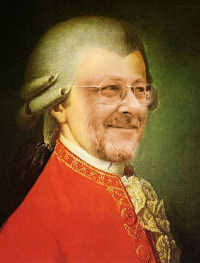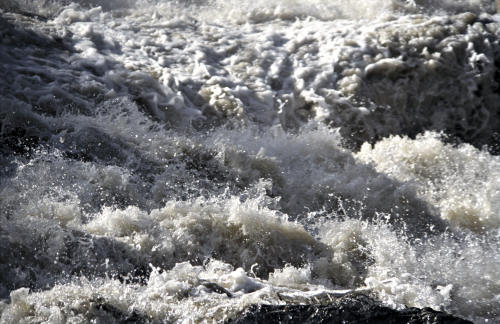A 365-Day Project
"We Are All Mozart"
A project to create
new works and change
the perception of the
music of our time.


 November 3, 2006
November 3, 2006 
It's not that the pace of change is so fast, but rather that the character of change is so dramatic. Musical eras snap back from complexity to simplicity. The Ars Nova snapped into the Renaissance, the Baroque into the Classical, the Modernist into the Minimalist. But there's something more going on, and reflecting on yesterday's commentary brought it forward.
Perhaps it's the overlapping snapping over the past fifty years. From its origins in glass and metal chemistry, the representation of form in photography has moved toward greater fidelity -- images of increasing detail, including motion and color, until the advent of television. Like the old J.S. Bach who kept composing well into the era when styles had eroded the substance underneath his feet to bury his last and greatest works in the sands of fashion, film kept producing broader images with formidable clarity. And then television eroded that clarity for the better part of two generations. Cinematic films were subject to pan-and-scan, and the clarity of film emulsion that had been brought to a perfection of resoution was reduced to few hundred fuzzy lines on an electron tube with questionable color fidelity. Resolution and fidelity technically continue to increase but in the most popular formats (tumbling all the way to grainy YouTube) it continues to fall -- a fall that is acceptable in exchange for access to the material.
Likewise, the audio recording arts rose from wiggly lines, a pin and a cone up through the finest digital rendering of sound that is nearly identical to the original moments captured in time, including spatial information in multiple channels and psychoacoustic recreations. Yet, like images, the public was happy to listen to cassettes, garishly mixed CDs and now the grainy compressed sound in downloadable MP3 recordings -- again, trading quality for access to the material.
In music itself, the quality of instrumentalists, the diversity of electroacoustic choices, the history of compositional techniques known & available are so deep to be advanced beyond any single composer's capacity to study them or understand them, much less put them to use. Great landscapes of sound did not end with Mahler's last symphonies or Schoenberg's Gurre-Lieder or Stravinsky's Rite. Economics constrained their public presence for many years, but the broad scores of composers such as Frank Martin or Kaikhosru Sorabji did not stop being written, and indeed came into some visibility again with the hours-long Steve Reich Drumming and the operas of Philip Glass. Many composers still labored in near-total eclipse, as with Clarence Barlow's evening-long Textmusik or my own twenty-seven-year looping cycle Detritus of Mating, but the composition of large forms delving deeply into their topics did not end with the economic collapse after World War I.
So did the interest in large forms and great depth of compositional spirit fall out of favor because of modernism? Likely not. The case has been made for another route, yet it does not explain the continuing failure of composers to bridge the creator-audience gap in the two generations since minimalism wiped the perceived modernist homeliness from the acoustic map. Something else is in play here.
That something else is the rise of the passive amateur: the consumer of music. This is Heisenberg incarnate, this effect of the passive -- even distant and virtual -- listener on the development of music. Before recording, one had to attend a concert or play music (the latter inclined to develop an internalized grasp of sound's production and interplay), to be present and active, to interact with the composer. Music was not a commodity, so each occurrence was an unrecoverable and remarkable event in time, not a product with static heft. Even in the realm of publishing, the goods were a catapult to more sales solely by participation in making the music. Effort was required. One did not passively consume a score.
Out-of-balance musical integration is the fruit of a century's worth of devaluating the temporal arts through their commodification. The art of composition or photography or recording is consumed, brought into the mass arena for consumption, digestion and excretion as a continuing diet of ultimate normalcy. It's not anything that hasn't been said before in these commentaries, but it offers one additional perspective: Those who are called professionals still use the tools of detail and expansion, even as tools once available only to professionals come across to the amateur participant for eventual presentation to the passive amateur.
See where this goes. The professional camera operator was once required to apprentice in an enormous body of basic skills (focus, exposure, chemistry, saturation, depth of field, angle, lighting, color balance, editing, synchronization...) to create the simplest film that today is possible with point-and-shoot video equipment and stock software. A professional composer once had to participate in the same enrichment in order to create the simplest music now possible with press-and-play synthesizers and software sequencers. It is not limited to the arts. Newsgathering, once a skill honed in the morgue (real and journalistic), is now handed to an entire news staff rather than experienced (or even apprentice) journalists, and even encouraged through a post-YouTubeian search for active amateurs by means of minute-of-fame offers such as CNN I-Reports.
Yesterday I made the case that we have a kind of allergy to participation, but that's an exaggeration as the proliferation of I-Reportism shows. The allergy is rather to committed participation, and the effect is a resentment of the committed participant. A faux-egalitarianism, particularly of the kind that drives Wikipedia, web spelling or defense of mispronunciation and arises out of a postmodernist (Zennite) belief in the whatever, becomes the hitchhiker's guide to cultural meaning.
Here's where it gets interesting. The effect of passive amateur consumption is a market shift that creates an artistic shift in terms of sheer survival. Whatever the naysayers might have felt about modernism, it wasn't the music's homeliness but rather its depth and expansiveness that formed the primary barrier to incorporation in the life of passive amateurs. Had modernism been overshadowed by neoclassicism and American prairie composition, it still would have suffered only the occasional success for the composition whose content was based upon the most instantly assimilable elements. The confluence of modernism and passive amateurism (consumerism) was a disaster for nonpop.
Which brings the story round to the present day and how one distinguishes the metagenres of pop from nonpop (aside from the myriad reasons already offered in previous commentaries, that is). They are known through their relative ease of access by passive amateurs. Active amateurs and professionals form a minor and quite different audience for music, one that listens to and participates in nonpop, and one that does not drive more than a niche market even in a Heisenbergian economy. The allergy to participation has become the snap-back from complexity to simplicity, non-participant simplicity has shallowed the cultural mainstream, the cultural mainstream has become the market, and the market has driven broad and deep participatory arts to the fringes of culture.
Perhaps YouTube can save it -- a not-quite-flippant thought worth considering. Another day for that.
* * *
Quick note: I am recording the Montpelier Chamber Orchestra concert tomorrow night and may not be here. Topics still on my mind are patents & copyright, food, and creative avoidance strategies.

Forgot to say: We had high water again last Friday. It looks pretty intense from below. The house is below.